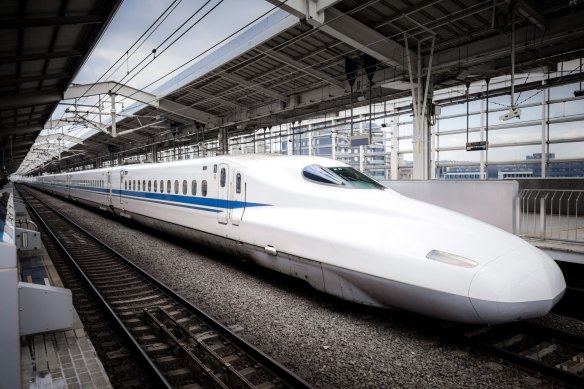This was published 1 year ago
Travelling by train in Japan is about to become a lot more expensive
Bad news. The Japan Rail Pass, the eternally popular all-inclusive ticket for Japan’s major transport network, for so long an absolute no-brainer for visitors to the country, is about to become a whole lot more expensive.
We’re talking almost 70 per cent more expensive. Japan Rail announced recently that, from an unspecified point in the future, probably around October this year, basic seven-day JR Passes will rise from 29,640 yen (about $330) to 50,000 yen ($560).

The JR Pass allows tourists unlimited travel on many of the countries trains, including bullet trains.Credit: iStock
That’s a brutal increase that will make the purchase much more difficult to justify for many visitors.
As it stands, the JR Pass is great value. If you’re planning to travel from, say, Tokyo to Kyoto and back again on the shinkansen (bullet train), it will cost about 26,000 yen. Given the JR Pass allows access to the JR network in its entirety, including regional trains, intra-city trains, airport trains and even some buses and ferries, you only need to do the smallest amount of extra travel – even just to and from Narita airport – before the JR Pass has paid for itself.
That won’t be the case with the price increase, which means visitors will have to think harder about how to get the best value out of their pass.
The old “two destinations” rule will go out the window. Right now, if you’re going to two destinations (using the example of Tokyo to Kyoto and back again), the JR Pass is a winner. But with the increase, you will need more than that.
Even if you’re visiting the “Golden Triangle” – Tokyo, Kyoto and Osaka – the JR Pass probably won’t be worth it. It will be cheaper to just buy point-to-point tickets.
The pass will represent much more value if you’re planning to go further afield, or make more stops.
If you want to leave Tokyo and visit, say, Kanazawa, Kyoto, Osaka and Hiroshima, then the JR Pass will still be good value. Given this is a seven-day pass, it will be worth setting yours to activate on the day you leave Tokyo, and to arrive at your final destination on day seven (if you activate it earlier, you’re only using the pass for cheap city trains in Tokyo on some days, which means you’re not getting full value).
Plan to do as much moving around as you can for the period your pass is activated (seven, 14 or 21 days), and then stay in one destination the rest of the time.
That said, if it makes more sense on your particular itinerary to activate your JR Pass immediately, for your airport transfers and onwards, it’s best to then use the JR network as much as possible.
So, in the likes of Tokyo and Kyoto, avoid the subway (most of which isn’t run by JR) where you can, and instead use the above-ground train system, which is.
The true secret to getting value out of this pass, however, is to thoroughly research the places you want to go, and figure out if and how you can get there via the JR network. For help with that, see jrailpass.com, and seat61.com
Sign up for the Traveller newsletter
The latest travel news, tips and inspiration delivered to your inbox. Sign up now.